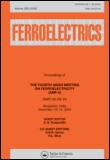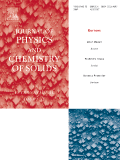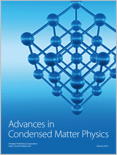
FERROELECTRICS
Scope & Guideline
Unveiling the Potential of Ferroelectric Applications
Introduction
Aims and Scopes
- Ferroelectric Materials Research:
The journal emphasizes the study of ferroelectric materials, including their synthesis, characterization, and applications. Research on both traditional and novel ferroelectric compounds is encouraged. - Multiferroics and Magnetoelectric Effect:
Research on materials exhibiting both ferroelectric and magnetic properties, known as multiferroics, is a key focus area. This includes the study of magnetoelectric coupling and its potential applications in devices. - Energy Storage and Conversion:
Papers focusing on the use of ferroelectric materials in energy storage systems, such as capacitors and batteries, as well as their role in energy conversion technologies, are prevalent. - Nanoferroelectrics and Thin Films:
The journal also covers advancements in the field of nanoferroelectrics, including thin films and nanostructured materials, which present unique properties and applications in modern electronics. - Computational and Theoretical Studies:
Theoretical modeling and computational studies that provide insights into the behavior and properties of ferroelectric materials are also significant contributions to the journal.
Trending and Emerging
- Energy Harvesting Technologies:
Research on piezoelectric energy harvesting systems is increasingly prominent, as scientists explore novel designs and materials for efficient energy conversion from mechanical vibrations. - Lead-Free Ferroelectric Materials:
There is a growing emphasis on lead-free ferroelectric materials due to environmental concerns, with significant research dedicated to developing and characterizing these materials. - Ferroelectric Nanocomposites:
The integration of ferroelectric materials with other materials to create nanocomposites presents new opportunities for enhanced properties and applications, leading to a rise in related publications. - Advanced Characterization Techniques:
Emerging characterization techniques, such as advanced microscopy and spectroscopy methods, are gaining traction, enabling deeper insights into ferroelectric materials at the nanoscale. - Interdisciplinary Applications:
Increased interest is observed in the interdisciplinary application of ferroelectric materials, particularly in fields such as biomedicine, sensors, and flexible electronics.
Declining or Waning
- Traditional Bulk Materials:
Research focusing solely on bulk ferroelectric materials seems to be decreasing, with a shift towards more innovative approaches involving nanostructures and composites. - Applications in Conventional Electronics:
There is a noticeable decline in papers discussing traditional electronic applications of ferroelectrics, as the field pivots toward exploring novel applications in energy harvesting and storage. - Basic Characterization Studies:
Basic studies on the characterization of ferroelectric properties without specific applications or advanced materials are less frequently published, indicating a trend towards application-oriented research.
Similar Journals

JOURNAL OF ELECTRONIC MATERIALS
Connecting Researchers to Groundbreaking Insights in ElectronicsWelcome to the Journal of Electronic Materials, a premier publication in the field of materials science. Published by Springer, this esteemed journal has been a beacon for groundbreaking research in electronic, optical, and magnetic materials since its inception in 1972. As an established resource, it boasts a commendable impact factor and categorically ranks in the second quartile (Q2) in key areas such as Condensed Matter Physics and Electrical and Electronic Engineering, as well as holding a respectable third quartile ranking in fields related to Electronic, Optical, and Magnetic Materials and Materials Chemistry. Researchers, professionals, and students can access a wealth of knowledge as we publish original articles, reviews, and cutting-edge research that push the boundaries of science and technology in these critical fields. Stay informed and engaged as we explore advancements that shape the future of electronic materials.

BULLETIN OF MATERIALS SCIENCE
Pioneering Research in the Heart of Materials ScienceBulletin of Materials Science, published by the Indian Academy of Sciences, is a distinguished journal that has been contributing to the field of materials science since its inception in 1979. With an ISSN of 0250-4707 and E-ISSN 0973-7669, it provides a platform for researchers to share groundbreaking studies and advancements in the mechanics of materials and general materials science. As of 2023, the journal holds a respectable Q3 ranking in both the Materials Science (miscellaneous) and Mechanics of Materials categories, highlighting its competitive position in the academic landscape. Although the journal currently does not operate under an open access model, it remains a vital resource for professionals and students keen on exploring innovative material developments and methodologies. With a commitment to promoting high-quality research, the Bulletin of Materials Science features rigorous peer-review processes, making it an essential reference for anyone engaged in the materials science domain.

Journal of Ovonic Research
Bridging Theory and Application in Material Technologies.Journal of Ovonic Research is a distinguished publication dedicated to advancing the fields of electronic, optical, and magnetic materials. Published by VIRTUAL CO PHYSICS SRL, this journal offers a platform for researchers to share innovative findings and developments that push the boundaries of technology and materials science. With an ISSN of 1842-2403 and an E-ISSN of 1584-9953, it provides an important service to the academic community, particularly within Romania and beyond. Despite its recent inception in 2011, the journal has gained traction in the academic landscape, reflecting a Q4 quartile ranking in crucial categories such as Electronic, Optical and Magnetic Materials, as well as in Physics and Astronomy. The Scopus rankings further underscore its positioning, ranking within the 25th to 37th percentile across various disciplines, making it a valuable resource for professionals and students alike. Although the journal currently operates on a non-open access basis, it remains committed to exploring the latest advancements in materials science, encouraging interdisciplinary collaboration and fostering a deeper understanding of surface, coating, and film technologies. As the field evolves, Journal of Ovonic Research stands as a beacon for scholarly communication, bridging the gap between research and practical application.

FlatChem
Connecting Researchers to Transformative Material DiscoveriesFlatChem, an esteemed journal published by ELSEVIER, serves as a premier platform for disseminating high-quality research in the dynamic fields of ceramic and composite materials, electronic and optical materials, materials chemistry, and surfaces, coatings, and films. Since its inception in 2017, the journal has garnered a robust reputation, evidenced by its rank in the top quartile (Q1) across multiple categories, including a commendable rank of #25/127 in Ceramics and Composites and #49/284 in Electronic, Optical and Magnetic Materials. With a focus on pioneering advancements and innovative methodologies, FlatChem not only highlights cutting-edge research but also promotes collaboration and knowledge exchange within the scientific community. The journal’s impact is underscored by its impressive rankings in Scopus, marking it as a vital resource for researchers, professionals, and students aiming to stay at the forefront of materials science. As an open-access journal, it ensures that groundbreaking findings are readily accessible, fostering a broader understanding and application of materials innovation worldwide. The journal is based in the Netherlands, with its headquarters located at RADARWEG 29, 1043 NX AMSTERDAM, NETHERLANDS. Join the vibrant community contributing to FlatChem and engage with the forefront of material advancements.

Magnetochemistry
Innovating the Intersection of Magnetism and ChemistryMagnetochemistry is a premier academic journal dedicated to the study of magnetic phenomena in chemistry, published by MDPI, a globally recognized publisher known for its dedication to open science. Since its inception in 2015, this Open Access journal has provided a platform for researchers to share their findings and innovations in the fields of chemistry, particularly in the areas of electronic, optical, and magnetic materials. With a commendable impact factor and competitive ranking, including Q2 in miscellaneous chemistry and materials chemistry, and achieving notable placements within the Scopus ranks, Magnetochemistry stands out as a vital resource for professionals and students alike. By facilitating access to groundbreaking research, it significantly contributes to the advancement of the field, encouraging collaboration and further exploration among its diverse readership. Located in Switzerland, Magnetochemistry offers not only accessibility through its open access model but also a commitment to high-quality and impactful research outputs.

JOURNAL OF PHYSICS AND CHEMISTRY OF SOLIDS
Catalyzing Innovation in Condensed Matter ScienceJOURNAL OF PHYSICS AND CHEMISTRY OF SOLIDS, published by Pergamon-Elsevier Science Ltd, is a distinguished international journal that has been at the forefront of disseminating cutting-edge research in the fields of physics, chemistry, and materials science since its inception in 1956. This journal, which is recognized for its high impact in the Q2 category across multiple subjects—including Chemistry (miscellaneous), Condensed Matter Physics, and Materials Science—serves as a vital platform for researchers, professionals, and students to engage with significant advances in solid-state physics and chemistry. With Scopus rankings placing it in the top 15% of its field across various domains, the journal plays a crucial role in shaping the scientific dialogue surrounding materials properties, synthesis, and applications. Although it does not currently offer open access options, the presented research is widely recognized for its quality and relevance, ensuring that published works contribute meaningfully to ongoing scholarly discussions.

Transactions on Electrical and Electronic Materials
Unveiling Insights in the World of Advanced MaterialsTransactions on Electrical and Electronic Materials, published by Springer, is a distinguished journal aimed at advancing the fields of electrical and electronic engineering, as well as electronic, optical, and magnetic materials. With an ISSN of 1229-7607 and an E-ISSN of 2092-7592, this journal is vital in disseminating impactful research and innovations, providing insights and significant findings that cater to both academia and industry. Holding a Q3 ranking in the categories of Electrical and Electronic Engineering and Electronic, Optical and Magnetic Materials, it serves as a reputable platform for sharing research that influences ongoing developments in these critical areas. The journal's converged years from 2011 to 2024 signify its commitment to providing a comprehensive review of technological advancements. Located in New York City, it appeals to a global audience of researchers, professionals, and students, enhancing their understanding of current trends and practices within the domain.

Journal of Materiomics
Leading Research in Surface Coatings and FilmsThe Journal of Materiomics, published by Elsevier, stands at the forefront of research in the interdisciplinary fields of materials science, particularly focusing on Electronic, Optical and Magnetic Materials, Metals and Alloys, and Surface Coatings and Films. Since its inception in 2015, this Open Access journal has fostered innovative research and theoretical advancements, facilitating the dissemination of knowledge with a global audience. With an impressive impact factor and consistently ranked in the top tiers of its categories — notably Q1 in 2023 for all its major focus areas, the journal positions itself as a vital resource for researchers, professionals, and students seeking to explore cutting-edge developments in materials science. Based in Amsterdam, Netherlands, the journal encourages the rigorous investigation of material interactions at the nanoscale, fostering advancements that underscore the applicability of materials across various industries. By providing a platform for high-quality research, the Journal of Materiomics plays a critical role in shaping the future of material technologies.

Nano Express
Fostering breakthroughs in biomaterials and beyond.Nano Express is an esteemed open-access journal published by IOP Publishing Ltd, dedicated to advancing research in the fields of nanotechnology and materials science. Since its launch in 2020, the journal has swiftly established itself as a vital resource for researchers and professionals, garnering significant recognition in various domains, including biomaterials, electronic, optical and magnetic materials, and polymers and plastics. With a commendable categorization in Scopus quartiles, it ranks in Q2 for Electronic, Optical and Magnetic Materials, and maintains a top percentile in several others, exemplifying its commitment to high-quality research dissemination. Located in the United Kingdom, this journal fosters a global dialogue among experts and newcomers alike, facilitating open access to innovative research that drives the future of nanotechnology. By offering a platform for groundbreaking studies and reviews, Nano Express aims to bridge the gap between theoretical understanding and practical application, championing the development of next-generation materials that have the potential to transform various industries.

Advances in Condensed Matter Physics
Connecting Researchers with the Latest DiscoveriesAdvances in Condensed Matter Physics is a distinguished journal published by HINDAWI LTD, dedicated to the rapid dissemination of high-quality research in the field of condensed matter physics. Since its inception in 2008, this Open Access journal has facilitated wide accessibility to cutting-edge findings and theoretical advancements, with aims to foster collaboration and innovation within the scientific community. With an ISSN of 1687-8108 and an E-ISSN of 1687-8124, the journal covers an extensive range of topics, from quantum materials to nanotechnology, ensuring relevance and engagement across various sub-disciplines. As a testament to its impact in the field, it is ranked in the Q3 category for 2023 within Scopus and holds a position in the 34th percentile for physics and astronomy. The journal's continuous commitment to publishing significant exploratory research until 2024 makes it a pivotal resource for researchers, professionals, and students eager to stay on the leading edge of condensed matter physics advancements.